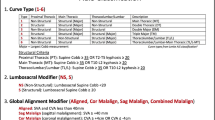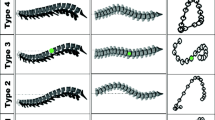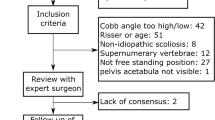Abstract
Background
Scoliosis in patients with neurofibromatosis type I (NF1) can manifest as dystrophic or nondystrophic curves. Dystrophic scoliosis is rapidly progressive, rendering treatment challenging. Radiographic characteristics have been reported to predict dystrophic scoliosis, but their reliability and predictive value have not been well described. The purpose of this study is to assess the interobserver reliability for eight radiographic characteristics of dystrophic scoliosis and to evaluate the sensitivity and specificity of these characteristics relative to the gold standard of a definitive clinical diagnosis.
Methods
Spine radiographs of 122 NF1 patients from multiple institutions were graded by five spine surgeons as dystrophic or nondystrophic, based on eight radiographic characteristics of dystrophic modulation: rib penciling, vertebral rotation, scalloping, wedging, spindling of transverse processes, short sharp angular curve, widened interpedicular distance, and atypical location. The curves were classified by each submitting institution as dystrophic or nondystrophic based on clinical outcome. Interobserver reliability analysis was performed using Fleiss kappa.
Results
For the 122 cases, the interrater agreement among the five readers for the diagnosis of dystrophic scoliosis was good at 0.61. The agreement for individual radiographic characteristic ranged from 0.62 for wedging to 0.14 (poor) for scalloping. Surgeons underestimated the number of dystrophic curves, rating from 45% to 67% of the curve patterns as dystrophic, compared to the gold standard, which revealed 68% of the curves to be dystrophic. On multivariate analysis, rib penciling, vertebral rotation, vertebral wedging, and atypical location were significantly associated with true dystrophic status (odds ratios of 2.4, 3.0, 2.4, and 3.0, respectively).
Conclusion
Overall dystrophic diagnosis can be assessed by radiographic characteristics. Better understanding of the predictive value of specific radiographic features may assist in early diagnosis of patients with dystrophic NF and assist surgeons in identifying dystrophic curve patterns and instituting prompt, appropriate treatment.
Level of Evidence
Level III.
Similar content being viewed by others
References
McKeever K, Shepherd CW, Crawford H, Morrison PJ. An epidemiological, clinical and genetic survey of neurofibromatosis Type 1 in children under sixteen years of age. Ulster Med J 2008;77:160–3.
Akbarnia BA, Gabriel KR, Beckman E, Chalk D. Prevalence of scoliosis in neurofibromatosis. Spine (Phila Pa 1976) 1992;17(8 suppl): S244–8.
Calzavara PG, Carlino A, Anzola GP, Pasolini MP. Segmental neurofibromatosis. Case report and review of the literature. Neurofibromatosis 1988;1:318–22.
National Institutes of Health Consensus Development Conference Statement: neurofibromatosis. Bethesda, MD, USA, July 13–15, 1987. Neurofibromatosis 1988;1:172–8.
Durrani AA, Crawford AH, Chouhdry SN, et al. Modulation of spinal deformities in patients with neurofibromatosis Type 1. Spine (Phila Pa 1976) 2000;25:69–75.
Lykissas MG, Schorry EK, Crawford AH, et al. Does the presence of dystrophic features in patients with Type 1 neurofibromatosis and spinal deformities increase the risk of surgery? Spine (Phila Pa 1976) 2013;38:1595–601.
R Development Core Team. R: a language and environment for statistical computing. Vienna, Austria. 2013. Available at: http://www.R-project.org/.
Byrt T. How good is that agreement? Epidemiology 1996;7:561.
Koptan W, ElMiligui Y. Surgical correction of severe dystrophic neurofibromatosis scoliosis: an experience of 32 cases. Eur Spine J 2010;19:1569–75.
Wang Z, Fu C, Leng J, et al. Treatment of dystrophic scoliosis in neurofibromatosis Type 1 with one-stage posterior pedicle screw technique. Spine J 2015;15:587–95.
Funasaki H, Winter RB, Lonstein JB, Denis F. Pathophysiology of spinal deformities in neurofibromatosis. An analysis of seventy-one patients who had curves associated with dystrophic changes. J Bone Joint Surg Am 1994;76:692–700.
Winter RB, Moe JH, Bradford DS, et al. Spine deformity in neurofibromatosis. A review of one hundred and two patients. J Bone Joint Surg Am 1979;61:677–94.
Nguyen R, Dombi E, Akshintala S, et al. Characterization of spinal findings in children and adults with neurofibromatosis Type 1 enrolled in a natural history study using magnetic resonance imaging. J Neurooncol 2015;121:209–15.
Author information
Authors and Affiliations
Corresponding author
Additional information
Author disclosures: ANL (grants from Department of Defense, during the conduct of the study; grants from K2M and Orthopediatrics, outside the submitted work), CGTL (personal fees from Greatbatch, Inc., outside the submitted work), AMB (grants from Dept of Defense NF Research Program, during the conduct of the study), DJS (other from Globus, outside the submitted work), LYC (other from Spine, Spine Journal, University of Louisville, and Scoliosis Research Society; personal fees from Washington University, AO Spine, Norton Healthcare; grants from Orthopedic Research and Educational Fund, Scoliosis Research Society, Norton Healthcare James R. Petersdorf; personal fees from University of Louisville, Association for Collaborative Spine Research, Center for Spine Surgery and Research, and Region of Southern Denmark; other from NuVasive, outside the submitted work), AHC (none), DAS (grants from the National Institutes of Health; grants from Shriners Hospital, during the conduct of the study; personal fees from Alexion and GLG, outside the submitted work), MGV (grants from Pediatric Orthopaedic Society of North America, during the conduct of the study; other from Pediatric Orthopaedic Society of North America and Biomet; personal fees from Stryker, Biomet, and Medtronic; other from Wellinks, outside the submitted work), CLM (Consultant, Recombinetics, Inc., Cancer Advisory Committee, including NF1-associated neoplasia; co–primary investigator, Synodos for NF1 Children’s Tumor Foundation, “An Innovative NF1 Drug Discovery Pipeline for Preclinical Development of Novel Drugs Quickly, Safely, and Effectively”), DWP (none).
Research reported in this publication was supported by 1) Department of Defense, Congressionally Directed Medical Research Program, Neurofibromatosis Research Program, Award Number W81HWH-10-1-0469; 2) the National Center for Advancing Translational Sciences of the National Institutes of Health, Award Number UL1TR000114; 3) Shriners Research Foundation; and 4) NIH NINDS K23 NS052500. The content is solely the responsibility of the authors and does not necessarily represent the official views of the National Institutes of Health.
Rights and permissions
About this article
Cite this article
Larson, A.N., Ledonio, C.G.T., Brearley, A.M. et al. Predictive Value and Interrater Reliability of Radiographic Factors in Neurofibromatosis Patients With Dystrophic Scoliosis. Spine Deform 6, 560–567 (2018). https://doi.org/10.1016/j.jspd.2018.02.011
Received:
Revised:
Accepted:
Published:
Issue Date:
DOI: https://doi.org/10.1016/j.jspd.2018.02.011




